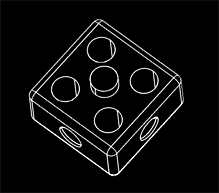
Kelas kita akan disambung semula pada Hari Rabu 7 September 2011...Saya mohon ampun & maaf jika ada salah silap sepanjang saya mengajar anda semua.....
Blog ini disediakan untuk rujukan pensyarah & para pelajar Semester 4 Sijil Pelukis Pelan Senibina, Kolej Komuniti Kementerian Pengajian Tinggi Malaysia dan juga kepada sesiapa yang berminat mendalami ilmu Lukisan Terbantu Komputer (CAD) 3 Dimensi (3D) melalui perisian AutoCAD. Ianya bertujuan untuk memberikan pendedahan tentang konsep 3D dalam CAD dan kaedah penggunaan AutoCAD dengan betul dalam menghasilkan Lukisan Persembahan 3D.



You can use REVOLVE on closed objects such as polylines, polygons, rectangles, circles, ellipses, and regions. You cannot use REVOLVE on 3D objects, objects contained within a block, polylines that have crossing or intersecting segments, or polylines that are not closed.

A wire frame model is a visual presentation of a three dimensional or physical object used in 3D computer graphics. It is created by specifying each edge of the physical object where two mathematically continuous smooth surfaces meet, or by connecting an object's constituent vertices using straight lines or curves. The object is projected onto the computer screen by drawing lines at the location of each edge.
Using a wire frame model allows visualization of the underlying design structure of a 3D model. Traditional 2-dimensional views and drawings can be created by appropriate rotation of the object and selection of hidden line removal via cutting planes.



'Thickness' boleh dilakukan dalam pelbagai paksi, samada paksi Y, X ataupun Z. Jika 'Thickness' garisan atau objek adalah sifar (0), ia tidak akan memberikan kita objek 3D. Jika kita letakkan nilai 'Thickness' adalah negatif, tebal garisan tersebut akan dinaikkan mengikut arah bertentangan. Sebagai contoh, kamu meletakkan nilai -3 pada 'Thickness' garisan pada paksi Z ia akan memberikan tebal garisan tersebut ke bawah sebanyak 3 unit.
Jenis-jenis objek/garisan yang boleh digunakan untuk 'Thickness' adalah 2D solid, Arcs, Circles, Lines, Polylines (including spline-fit polylines, rectangles, polygons, boundaries, and donuts), Text (only if created as a single-line text object using an SHX font), Traces & Points.
 Thickness.
Thickness.When new objects are created, they have the specified 3D thickness.
The selected objects change to display the specified 3D thickness.